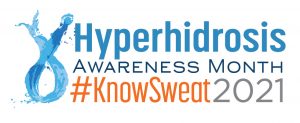Sam’s Severe Sweating Story
Like many people with primary hyperhidrosis (Hh) or excessive, uncontrollable sweating, I am most affected by Hh on the palms of my hands, soles of my feet, and in my underarms. My chronic extreme sweating isn’t caused by an underlying medical condition and it can occur at any time, even when I’m not hot, exercising, or in a stressful situation. Without treatment, visible beads of sweat drip from my hands and shoes slip off my feet. In circumstances where someone else would sweat “normally,” my sweat glands are in overdrive, often resulting in general wetness and a chill throughout my body. Sometimes, my fingers and toes swell, too.
I can’t recall when I was diagnosed or when I first learned the word “hyperhidrosis,” but I know that I have suffered with this problem my entire life. Throughout my childhood, I avoided games and activities that involved holding hands. I hated having to apologize for my palms being wet. At school, I had trouble holding a pen and had to lay extra papers on my notebook to absorb sweat, so as not to moisten my notes or smudge any ink. As an adult, not much has changed but I’ve gotten more creative with my “hacks.” I’m careful to choose the right shoes and to travel with ice packs, baby wipes, deodorant, a towel, and extra underwear and socks. Excess sweat can restrict my ability to type on a keyboard or handle papers at work. I often need help turning doorknobs and opening jars that require a good grip. No matter the circumstances, I always have to make accommodations to deal with my sweating, so much so that, over the years, hyperhidrosis has caused me great embarrassment and social anxiety. It affects my body image, self-esteem and some relationships.
Since hyperhidrosis only impacts a small(ish) percentage of the population, the condition is not often widely diagnosed or understood, even (in my experience) by a lot of healthcare providers. My situation has often been dismissed or brushed under the rug with pat responses like: “Get used to it” or “You’ll grow out of it” or “You must be nervous.” Through a lot of trial and error, I have now found some successful treatments that help me, but mostly they provide “relief” and not a cure.
I am so appreciative of any and all healthcare professionals who research this condition, study best practices for its diagnosis and effective treatment, and stay abreast of the latest research and discoveries. People suffering with hyperhidrosis, like me, really need the validation and acceptance that accurate diagnosis, understanding, and thoughtful treatment can bring.
November is Hyperhidrosis (Hh) Awareness Month. In a study presented at the American Academy of Dermatology, results showed that among 500 Hh  sufferers, 13.8% had anxiety, 12.4% had depression and 6.4% had attention deficit disorder — all of these are rates significantly higher than those reported in the general population. You can learn more and learn how to better help through comprehensive diagnosis, treatment, and coverage/reimbursement information available from the International Hyperhidrosis Society at SweatHelp.org. And you can get involved in Hyperhidrosis Awareness Month on: Facebook @SweatingStopsHere, Twitter @WeKnowSweat, and Instagram @WeKnowSweat.
sufferers, 13.8% had anxiety, 12.4% had depression and 6.4% had attention deficit disorder — all of these are rates significantly higher than those reported in the general population. You can learn more and learn how to better help through comprehensive diagnosis, treatment, and coverage/reimbursement information available from the International Hyperhidrosis Society at SweatHelp.org. And you can get involved in Hyperhidrosis Awareness Month on: Facebook @SweatingStopsHere, Twitter @WeKnowSweat, and Instagram @WeKnowSweat.
Content published with permission from the International Hyperhidrosis Society.
Did you enjoy this article? Find more on Hyperhidrosis here.

